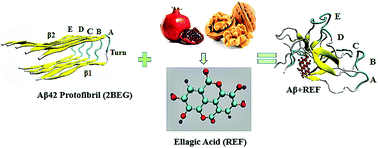Destabilization potential of phenolics on Aβ fibrils: mechanistic insights from molecular dynamics simulation†
Abstract
The clinical signature of Alzheimer's disease (AD) is the deposition of aggregated Aβ fibrils that are neurotoxic to the brain. It is the major form of dementia affecting older people worldwide, impeding their normal function. Finding and testing various natural compounds to target and disrupt stable Aβ fibrils seems to be a promising and attractive therapeutic approach. Four phenolic compounds from plant sources were taken into consideration for the present work, and were initially screened by docking. Ellagic acid (REF) came out to be the best binder of the Aβ oligomer from docking studies. To test the destabilization effect of REF on the Aβ oligomer, MD simulation was conducted. The simulation outcome obtained clearly indicates a drift of terminal chains from the Aβ oligomer, leading to the disorganization of the characteristically organized cross β structure of the Aβ fibrils. Increased values of RMSD, Rg, RMSF, and SASA are indicative of the destabilization of the Aβ fibril in the presence of REF. The disruption of salt bridges and a notable decline in the number of hydrogen bonds and β-sheet content explain the conformational changes in the Aβ fibril structure, ceasing their neurotoxicity. The MM-PBSA results revealed the binding of REF to chain A of the Aβ oligomer. The destabilization potential of ellagic acid, as explained by the MD simulation study, establishes it as a promising drug for curing AD. The molecular-level details about the destabilization mechanism of ellagic acid encourage the intensive mining of other natural compounds for therapeutic intervention for AD.



 Please wait while we load your content...
Please wait while we load your content...